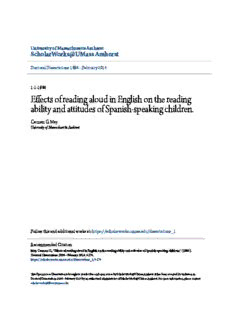
Effects of reading aloud in English on the reading ability and attitudes of Spanish-speaking children. PDF
Preview Effects of reading aloud in English on the reading ability and attitudes of Spanish-speaking children.
UUnniivveerrssiittyy ooff MMaassssaacchhuusseettttss AAmmhheerrsstt SScchhoollaarrWWoorrkkss@@UUMMaassss AAmmhheerrsstt Doctoral Dissertations 1896 - February 2014 1-1-1986 EEffffeeccttss ooff rreeaaddiinngg aalloouudd iinn EEnngglliisshh oonn tthhee rreeaaddiinngg aabbiilliittyy aanndd aattttiittuuddeess ooff SSppaanniisshh--ssppeeaakkiinngg cchhiillddrreenn.. Carmen G. May University of Massachusetts Amherst Follow this and additional works at: https://scholarworks.umass.edu/dissertations_1 RReeccoommmmeennddeedd CCiittaattiioonn May, Carmen G., "Effects of reading aloud in English on the reading ability and attitudes of Spanish- speaking children." (1986). Doctoral Dissertations 1896 - February 2014. 4174. https://scholarworks.umass.edu/dissertations_1/4174 This Open Access Dissertation is brought to you for free and open access by ScholarWorks@UMass Amherst. It has been accepted for inclusion in Doctoral Dissertations 1896 - February 2014 by an authorized administrator of ScholarWorks@UMass Amherst. For more information, please contact [email protected]. EFFECTS OF READING ALOUD IN ENGLISH ON THE READING ABILITY AND ATTITUDES OF SPANISH-SPEAKING CHILDREN A Dissertation Presented By CARMEN GRACIELA MAY Submitted to the Graduate School of the University of Massachusetts in partial fulfillment of the requirements for the degree of DOCTOR OF EDUCATION May 1986 School of Education Carmen Graciela May 1986 All Rights Reserved EFFECTS OF READING ALOUD IN ENGLISH ON THE READING ABILITY AND ATTITUDES OF SPANISH-SPEAKING CHILDREN A Dissertation Presented By CARMEN GRACIELA MAY Approved as to style and content by: Luis Fuentes, Chairperson of Committee Mario D. Fanti Dean To My daughter, Sheila, for her understanding and My Parents, for their caring iv ACKNOWLEDGEMENTS It is the custom in these matters to write some words of thanks to all those who in one way or another helped one through this enormous endeavor. If there is one solitary thing to be learned from this experi¬ ence, it is that it cannot be done alone. Yet how does one thank all the wonderful people who always seemed to be in the right place at the right time. From beginning to end, there was the inspiration, the enthusiasm, the continuous support, the dedication and trust, the faith, and, most important, the love. For all these things, I offer my humble but most sincere thanks to the members of my committee: Luis Fuentes, Sonia Nieto, and William Moebius; and to the members of my family: my parents and step-parents, my aunt and uncle, my daughter, Sheila, and to Jimmy. I would also like to express my most heartfelt thanks to my very special friends in Amherst: Brunilda, Carmencita, Gloria, Miguel, Efrain, Lizzette, Ingrid, Manolo, Jane, Nelson, and specially to Dora-- all of whom demonstrated a magical control over time, making sad times brief, and happy times long and full. For the teachers and students who worked in this study and the administrators who allowed us to work together, and for Dr. Masha Rudman who opened the doors to a world I had until now ignored, I cannot find words to adequately express my gratitude. I thank them most heartily because I know I could not have done this without them. Finally, but certainly not least, my thanks go to the cheering sec¬ tion of the English Department at Bayamon Technological University v College in Puerto Rico, especially to Olga for the prodding and to Isidra for the typing of so many drafts, Thank you and may God bless you all. vi Effects of Reading Aloud in English on the Reading Ability and Attitudes of Spanish-Speaking Children (May 1986) Carmen Graciela May, B.A., Long Island University M.S., University of Bridgeport Ed.D., University of Massachusetts Directed by: Professor Luis Fuentes The primary goal of this dissertation is to examine some of the effects of a read aloud program on the attitudes toward reading and the English reading comprehension of Spanish-speaking children in the primary grades. The first chapter provides the historical background of teaching methods in English as a second language. The chapter describes the unsteady relationship between the techniques developed for foreign and/or first language teaching and second language learning. This study poses the question of whether reading aloud, a technique widely used in English monolingual classrooms, can be transferred to the second language class¬ room where the conceptual, experiential, and linguistic background of the English as a second language learner is so profoundly different from that of the English monolingual learner. The effects of this transference on the second language learner's reading ability and the attitudes toward reading constitute the focus of the study. The second chapter reviews the literature in the areas of reading and bilingualism, reading aloud, and reading attitudes. The review points out two significant findings. First, it reveals that there is very little cogent research available on the topic of reading and bilingualism. Second, the literature available on reading aloud and the measurement of reading attitudes was found to focus almost exclusively on English monolingual learners rather than on second language learners. The third chapter describes the research plan, which follows an experimental design using a control group, pre- and post-testing, and t-test analysis of the responses of fifty-three Spanish-speaking stu¬ dents enrolled in a bilingual elementary program. The tests used were the Gates-MacGinitie Reading Test, a standardized measure, and an atti¬ tude measure adapted by the researcher. A teacher's observation check¬ list was also used to record students' responses to the readings. The findings of the study presented in Chapter IV are briefly sum¬ marized as follows: 1. A positive trend supporting the use of reading aloud in the ESL classroom was observed, although the find¬ ings were not statistically significant. 2. Teacher observations indicate that individual reading selections stimulated increased verbal and nonverbal student interaction during the read aloud sessions. Chapter V offers a summary of the study, the conclusions, and the recommendations for applications of the findings, improvement of the study, and possible further research. vi i i
Description: